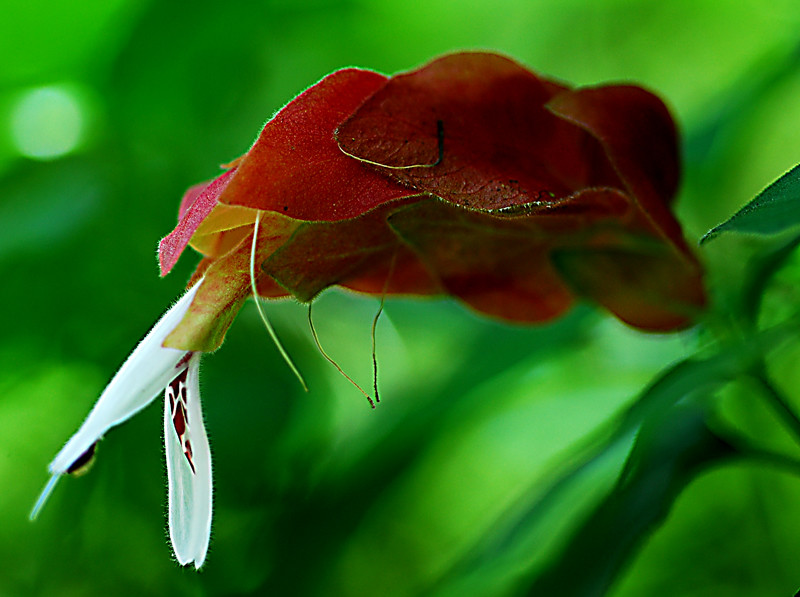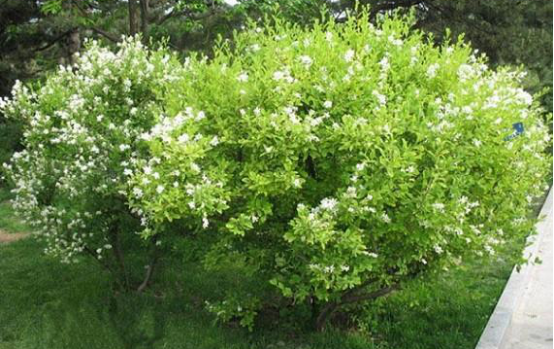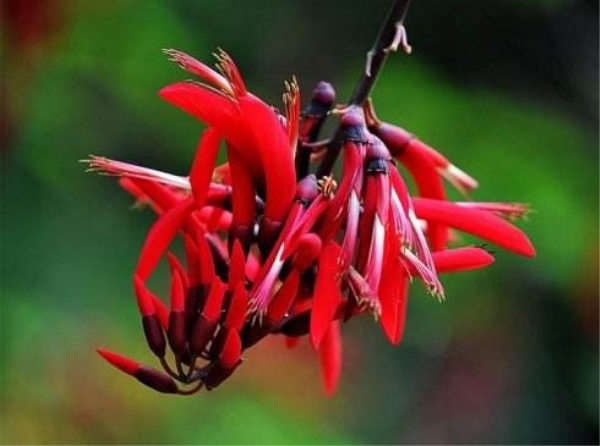The Culture method of Shrimp Flower
First of all, shrimp clothing flowers will bloom in all seasons, so we have to separate different seasons and different breeding methods.
I. Sufficient light
In the spring and autumn season, we need to make the shrimp flower fully exposed to light, the plant can not be in a state of no sunlight for a long time, otherwise it is easy to make the plant grow excessively, affecting the quantity and quality of flowering.
2. Appropriate fertilization
Fertilization in spring and autumn two seasons inside, should maintain sufficient water and fertilizer. Shrimp clothing flower demand quality is still very high, need to keep its pot soil moist, fertilization and application of a decomposed liquid fertilizer, flowering time to apply phosphorus fertilizer.
III. Appropriate moisture
In summer, it's a rainy season, so pay attention to drainage. However, when there is plenty of sunshine, the water demand is still very large, so remember to spray water frequently to maintain the fineness, which can also reduce the temperature. Also, if the temperature gradually rises and the light becomes more and more intense, remember to do a good job of shading and ventilation in time. Put the shrimp flower in a cool and ventilated place, and cannot always shine in the sun.

Culture method of shrimp flower
Culture method of shrimp shell flower
Basic information on shrimp flower
Scientific name: Callispidia guttata alias: shrimp flower, shrimp clothing grass, yellow shrimp flower, fox tail wood, fox tail flower, shrimp flower, shrimp flower, unicorn spit bead, duckbill flower, yellow fox tail wood. The Japanese name is Omi.
Family belongs to: acanthaceae, shrimp clothing flower genus (also known as unicorn Tuzhu genus).
Evergreen subshrubs, 70 - 80 cm tall. Basal lignification, many branches, branches and stems thin and soft. Leaves ovate, leaf tip pointed, lower part narrowed, 7 ~ 8 cm long, pilose. Flowers from April to November, peak from April to June; spikes terminal, ca. 8 cm long, slightly pendulous; persistent bracts brown, red, yellow-green or yellow, white flowers, protruding bracts, corolla with 2 lips, lower lip with red spots. Capsule, with 4 or 2 seeds.
Shrimp clothing flowers up to nearly 10 cm inflorescence bract overlapping, similar to lobster, also like fox tail, unique and interesting, and flowering long, but also easy to maintain, is suitable for home cultivation of flowering plants.
[Shrimp clothing flowers are common flowers]
(1)Myricaria purpurea (c. Atropurpurea): Plant height about 1 meter, purple flowers.
(2)C. gw to cv. Yellow Queen): Cultivated variety of rape flower, yellow bud, white flower.
(3)Violent fox tail wood (C.v/o/e/): plant height of about 1 meter, flowers violet.
(4)Foxtail californiana (C. California): Flowers are bright red.
[Shrimp clothing flower propagation] cuttage, plant division, seeding.
(1)Cuttings: usually in April to June or September to October, spring cuttings are the best. Cut the branches with a length of 10 ~ 15 cm, strong growth and short internodes as cuttings, place them in the shade, keep the room temperature at 20 ~ 25°C, and spray them frequently to keep the environment moist. Rooting and survival can be achieved in half a month. Spring planting survived the autumn flowering of the year, autumn planting the spring flowering of the following year.
(2)Plant rationing: combined with pot turning in spring.
(3)Sowing: Since the fruit will automatically pop up in the sun after ripening, the seeds can be shot to a place about 1 meter away, so it is difficult to collect seeds, and the fruits of potted plants are not easy to mature, so they are rarely used.
[Shrimp clothing flower cultivation points]
(1)Temperature: like warm, the most suitable temperature for growth is 18~251C. If the temperature above 10 ° C can be maintained and sufficient sunlight is given, it can continue to bloom in winter. But when the temperature is low, the bract color of the shop is dim and not beautiful. No enzyme, minimum age is 5X:
(2)Illumination: like sufficient sunlight, also resistant to half shade, but avoid strong direct sunlight.
Shade should be provided from May to September, but shade should be removed during rainy season, so as not to make the light too dark, so as to facilitate the growth and flowering of plants. When the light is insufficient, the plant grows excessively, the flower ear thin grows, the flower bract color becomes pale, causes the plant shape and the flower color to be not beautiful. Adequate sunlight should be provided from October to April of the following year.
(3)Watering: like wet soil environment, during the growth period should be fully supplied with water, keep the pot soil moist, but avoid pot soil wet waterlogging, otherwise yellow leaves, flowers wilted, and even rotten roots. Winter season should be controlled watering, so that the basin soil with dry, in order to facilitate winter.
(4)Ambient humidity: like humid environment, suitable air relative humidity of 50%~ 60%. In summer, when the weather is hot, sunny and dry, spray water on the plants and surrounding areas to create a moist and cool environment.
(5)Fertilization: Due to long flowering period and high nutrient consumption, nitrogen, phosphorus and potassium fertilizers are applied once every 10 days in the growing season to meet the nutrient needs of branch growth and flowering. However, fertilizer and water should not be too much to keep the plant short and compact. Especially avoid applying nitrogen fertilizer alone, otherwise the branches and leaves grow vigorously and blossom less. Stop applying nitrogen fertilizer in September and apply phosphorus and potassium fertilizer twice to improve cold resistance. Stop fertilizing in winter.
(6)Pruning: germination is strong. The plants are pruned every spring in conjunction with pot turning. The branches are mainly cut short, generally cutting off about 1/3 of the branch length to control plant height and promote branching. Reproductive young plants in the long to 10 cm to be removed, in order to promote branching, the formation of plump plant shape. Because the flower is born at the top of the new branch, after each flower withers, it is necessary to cut off the residual flowers in time and apply fertilizer to promote the new branch and bloom continuously.
(7)Potting and pot turning: Rooted seedlings are planted in pots with a diameter of 10 cm. Adult plants need to be turned over once every 1 ~ 2 years, which can be carried out in spring. After turning over the basin, first place it in a semi-shady place, and then move it to a place with sufficient light after new leaves are released. Do not choose soil, but with loose fertilizer fertile, good drainage sandy loam is better, basin soil can be used humus soil, peat soil, garden soil, coarse sand or pearlite and other materials.
(8)Pest control: powdery mildew and scale insects,'red spider, whitefly and other pests harm.
[Common problems of shrimp clothing flower cultivation]
common problems Cause Plants thin and thin. Floral bracts pale It is usually caused by insufficient light. The branches and leaves are vigorous, but the flowers are few. is the cause of excessive application of fertilizer, especially nitrogen.
Shrimp clothing flower culture methods and precautions Chinese scientific name Shrimp clothing flower
Callispidia guttata
Also known as shrimp flower, shrimp clothing grass, fox tail wood, unicorn spit beads
kingdom planta
Phylum Angiospermum
Class Dicotyledonous
Stellaria
Scrophulariales
ACANTHIDAE
It belongs to the genus Kirin.
Echinochloa sinensis
Regional origin Mexico, China mostly cultivated in greenhouses
Justicia Brandegeana
Calliaspidia guttata is a plant of the genus Unicorn in the family Araceae. Its red bracts overlap into a string of downward tilts. Its inflorescence is about 10cm long, like lobster and fox tail. It is very interesting. It flowers all the year round, suitable for potted plants, placed on indoor elevated viewing, but also for flower bed layout. Shrimp clothing flowers like warm, humid environment, the lowest temperature 5℃ to 10℃, like light bogey exposure, there is a certain ability to withstand shade. Shrimp coat flower has strong resistance and few diseases and pests. In greenhouse culture, attention should be paid to the prevention and control of scale insects and red spiders.
1. Morphological characteristics
Evergreen subshrubs, 1 - 2m tall, hairy throughout. Stems rounded, slender, much branched, young stem nodes purplish red. Leaves ovate, apex mucronate, base cuneate, entire. Spikes terminal, 6 - 9cm long, pendulous, with brown, red, yellow-green, yellow persistent bracts. Flowers white, extending to bract, flower points up and down 2 lips, upper lip entire or slightly split, lower lip shallowly split, there are 3 lines of purple mottled pattern. Stems rounded, base much branched, pubescent. Leaves 2.5-6 cm long, entire, with short hairs on both surfaces. Spikes pendulous, with bright, brownish red persistent large bracts; bracteoles ovate-lanceolate; calyx lobes 5, puberulent; corolla white, extending beyond bracts, with short hairs outside, labial, upper lip entire or slightly lobed, lower lip lobed, with 3 rows of purple spots;2 stamens.
2. Growth habits
Neutral and slightly acidic soils that prefer moisture, drought tolerance, porosity, fertility and good drainage. Full sunlight or half sunlight, likes warm, moist environment, cultivated in greenhouse. The minimum temperature needs to be: 5~10℃, suitable for growth temperature: 18~28℃, like sunlight is also more resistant to shade, avoid exposure, like humidity. Flowers bloom all year round. Fruiting year-round. Habits: likes warm, humid environment, cultivated in greenhouse. The minimum temperature should be between 5 and 10 ° C. The sun is also more resistant to shade, avoid exposure, like wet. Flowers bloom all year round.
3. Geographical distribution
Native to Mexico, cultivated worldwide.
4. Cultivation and maintenance
Cuttage planting as long as the temperature is appropriate, all seasons can be inserted, but mainly in spring and summer. If cutting in summer, should pay attention to shade moisture. 2 to 3 full internodes of the current year are cut as cuttings. Under the same temperature condition, the tender shoots can take root faster. Insert the base 1 node into the sandy soil, take root about 10 days at room temperature 20℃, and bloom in the next year. Yellow sand, vermiculite or pearlite can be used as cutting substrate, young cuttings to substrate strict disinfection. After the cuttings take root, transplant them in time and shade them properly. After the new leaves grow out, move them to a place with sufficient sunshine. After cutting, attention should be paid to the following management: temperature: the optimum temperature for cutting rooting is 20~30℃, below 20℃, cutting rooting is difficult and slow; above 30℃, the upper and lower two cuttings of cutting are easily infected by bacteria and rot, and the higher the temperature, the greater the proportion of rot. After cutting encounter low temperature, insulation measures are mainly used to cut the pot or container wrapped with film; cutting temperature is too high temperature, cooling measures are mainly to cut shade, to cover 50%~80% of the sun, at the same time, to cut spray, 3~5 times a day, sunny temperature higher spray times are more, rainy days lower temperature is larger, spray times are less or not spray.
Humidity: After cutting, the relative humidity of the air must be maintained at 75%~85%. The basic requirement of cuttings rooting is to ensure that cuttings are fresh and capable of photosynthesis to produce rooting substances before rooting. However, the cuttings without roots cannot absorb enough water to maintain the water balance in their bodies. Therefore, it is necessary to reduce the evaporation of water from cuttings by spraying: under the condition of shade, spray the cuttings 3~5 times a day. The higher the temperature in sunny days, the more the spraying times. The lower the temperature in rainy days, the less or no spraying times. However, excessive spraying, cuttings are easily infected and rotted by germs, because many kinds of germs exist in water.
Light: Cuttage propagation can not be separated from sunlight irradiation, because the cuttings also continue to carry out photosynthesis to produce nutrients and rooting substances to supply their rooting needs. However, the stronger the light, the higher the temperature in the cutting body, the more vigorous the transpiration of the cutting, the more water consumed, which is not conducive to the survival of the cutting. Therefore, after cuttage, the sun must be blocked by 50%~80%. After the root system grows out, the shading net is gradually removed: the shading net is removed at 4:00 p.m. every day on a sunny day, and the shading net is covered before 9:00 a.m. the next day.
- Prev

Maintenance method of rhododendron plum
1. Selection of potted soil. Rhododendron plum can be cultivated outdoors on the ground, or can be watched in pots. When potted culture, the appropriate flowerpot should be selected according to the size of the rhododendron plant, and the filter layer composed of broken tiles should be put on the bottom of the pot before filling.
- Next

The Culture method of Longya Flower
Soil because the dragon tooth flower is a larger flower, so we had better plant it in a large flowerpot and choose a well-drained and fertile and loose sandy loam. If the soil is too poor, it will affect the growth of Longya flower, resulting in its poor growth. Temperature Longya likes to grow in a warm and humid environment and is slightly resistant to semi-shade.
Related
- Fuxing push coffee new agricultural production and marketing class: lack of small-scale processing plants
- Jujube rice field leisure farm deep ploughing Yilan for five years to create a space for organic food and play
- Nongyu Farm-A trial of organic papaya for brave women with advanced technology
- Four points for attention in the prevention and control of diseases and insect pests of edible fungi
- How to add nutrient solution to Edible Fungi
- Is there any good way to control edible fungus mites?
- Open Inoculation Technology of Edible Fungi
- Is there any clever way to use fertilizer for edible fungus in winter?
- What agents are used to kill the pathogens of edible fungi in the mushroom shed?
- Rapid drying of Edible Fungi

